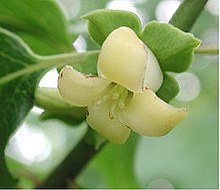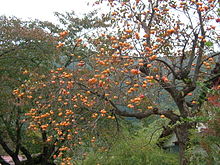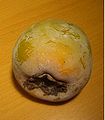| Persimmon | |
|---|---|
 | |
| American persimmon flower | |
| Scientific classification | |
| Kingdom: | Plantae |
| (unranked): | Angiosperms |
| (unranked): | Eudicots |
| (unranked): | Asterids |
| Order: | Ericales |
| Family: | Ebenaceae |
| Genus: | Diospyros |
| Species | |
| See text | |
Like the tomato, it is not considered a "common berry", but is in fact a "true berry" by definition.
Contents
|
Select species
The shizi (柿子 in Chinese), also known as Japanese Persimmon or kaki (柿) (Diospyros kaki), is the most widely cultivated species. These are sweet, slightly tangy fruits with a soft to occasionally fibrous texture. This species, native to China, is deciduous, with broad, stiff leaves. Cultivation of the fruit extended first to other parts of east Asia, and was later introduced to California and southern Europe in the 1800s, to Brazil in the 1890s,[4] and numerous cultivars have been selected. It is edible in its crisp firm state, but has its best flavor when allowed to rest and soften slightly after harvest. The Japanese cultivar 'Hachiya' is a widely grown cultivar. The fruit has a high tannin content which makes the immature fruit astringent and bitter. The tannin levels are reduced as the fruit matures. Persimmons like 'Hachiya' must be completely ripened before consumption. When ripe, this fruit comprises thick pulpy jelly encased in a waxy thin skinned shell. "Sharon Fruit" (named originally after Sharon plain in Israel) is the trade name for D. kaki fruit that has had its astringency artificially removed. The sharon fruit has no core, is seedless, particularly sweet, and can be eaten whole.[5] Eating the sharon fruit regularly is believed to reduce the risk of developing atherosclerosis heart attacks.[6]
Nanyo City, Yamagata, Japan. October 2005.
The American Persimmon (Diospyros virginiana) is native to the eastern United States and is higher in nutrients like vitamin C and calcium than the Japanese Persimmon.[8] Its fruit is traditionally eaten in a special steamed pudding in the Midwest & sometimes its lumber is used as a substitute for ebony, eg, in instruments.
The Black Persimmon or Black Sapote (Diospyros digyna) is native to Mexico. Its fruit has green skin and white flesh, which turns black when ripe.
The Mabolo or Velvet-apple (Diospyros discolor) is native to the Philippines. It is bright red when ripe. It is also native to China, where it is known as shizi. It is also known as Korean Mango.
There are many other species of Diospyros that are inedible to humans, and thus have little or no commercial value for their fruit.
Fruit
Commercially, there are generally two types of persimmon fruit: astringent and non-astringent.The heart-shaped Hachiya is the most common variety of astringent persimmon. Astringent persimmons contain very high levels of soluble tannins and are unpalatable (or "furry" tasting) if eaten before softening. The astringency of tannins is removed through ripening by exposure to light over several days, wrapping the fruit in paper (probably because this increases the ethylene concentration of the surrounding air), and/or artificially with chemicals such as alcohol and carbon dioxide which change tannin into the insoluble form. This bletting process is sometimes jumpstarted by exposing the fruit to cold or frost which hastens cellular wall breakdown. These astringent persimmons can also be prepared for commercial purposes by drying. Tanenashi fruit will occasionally contain a seed or two, which can be planted and will yield a larger more vertical tree than when merely grafted onto the D. virginiana rootstock most commonly used in the U.S. Such seedling trees may produce fruit that bears more seeds, usually 6 to 8 per fruit, and the fruit itself may vary slightly from the parent tree. Seedlings are said to be more susceptible to root nematodes.
The non-astringent persimmon is squat like a tomato and is most commonly sold as fuyu. Non-astringent persimmons are not actually free of tannins as the term suggests, but rather are far less astringent before ripening, and lose more of their tannic quality sooner. Non-astringent persimmons may be consumed when still very firm, and remain edible when very soft.
There is a third type, less commonly available, the pollination-variant non-astringent persimmons. When fully pollinated, the flesh of these fruit is brown inside -known as goma in Japan, and the fruit can be eaten firm. These varieties are highly sought after and can be found at specialty markets or farmers markets only.[citation needed] Tsurunoko, sold as "Chocolate persimmon" for its dark brown flesh, Maru, sold as "Cinnamon persimmon" for its spicy flavor, and Hyakume, sold as "Brown sugar" are the three best known.
Before ripening, persimmons usually have a "chalky" taste or bitter taste.
|
| Nutritional value per 100 g (3.5 oz) | |
|---|---|
| Energy | 293 kJ (70 kcal) |
| Carbohydrates | 18.59 g |
| Sugars | 12.53 g |
| Dietary fiber | 3.6 g |
| Fat | .19 g |
| saturated | .02 g |
| Protein | .58 g |
| Riboflavin (Vit. B2) | 2.5 mg (167%) |
| Folate (Vit. B9) | 8 μg (2%) |
| Vitamin C | 7.5 mg (13%) |
| Calcium | 8 mg (1%) |
| Iron | .15 mg (1%) |
| Sodium | 1 mg (0%) |
Diospyros kaki, raw Percentages are relative to US recommendations for adults. Source: USDA Nutrient database | |
Fruit production
The table below shows figures of persimmons for the world's top ten persimmon producing countries according to FAO statistics.
|
Culinary uses

Peeled, flattened, and dried persimmons (shibing, 柿餅) in a Xi'an market
In Korea, dried persimmon fruits are used to make the traditional Korean spicy punch, sujeonggwa, while the matured, fermented fruit is used to make a persimmon vinegar called gamsikcho (감식초), which is alleged to have a variety of health benefits. The hoshigaki tradition traveled to California with Japanese American immigrants.
In Taiwan, fruits of astringent varieties are sealed in jars filled with lime water to get rid of bitterness. Slightly hardened in the process, they are sold under the name "crisp persimmon" (cuishi 脆柿) or "water persimmon" (shuishizi 水柿子). Preparation time is dependent upon temperature (5 to 7 days at 25–28 °C). In some areas of Manchuria and Korea, the dried leaves of the fruit are used for making tea. The Korean name for this tea is ghamnip cha (감잎차).
In the state of Indiana (USA), persimmons are harvested and used in a variety of dessert dishes most notably pies. It can be used in cookies, cakes, puddings, salads, curries [2] and as a topping for breakfast cereal. Persimmon pudding is a dessert using fresh persimmons. An annual persimmon festival, featuring a persimmon pudding contest, is held every September in Mitchell, Indiana. Persimmon pudding is a baked pudding that has the consistency of pumpkin pie but resembles a brownie and is almost always topped with whipped cream. Persimmons may be stored at room temperature (20 °C) where they will continue to ripen. In northern China, unripe persimmons are frozen outside during winter to speed up the ripening process.
Medical effects
The Sharon fruit was found to contain high levels of dietary fibre, phenolic compounds, potassium, magnesium, calcium, iron and manganese. They are also rich in vitamin C and beta carotene. Regular consumption of the fruit is believed to reduce the risk of atherosclerosis heart attacks. A separate research project showed that a diet rich in persimmons improved lipid metabolism - the way the body copes with fat - in laboratory rats.[10]The fruits of some persimmon varieties contain the tannins catechin and gallocatechin,[11] as well as the candidate anti-tumor compounds betulinic acid and shibuol.[citation needed]
Unripened persimmons contain the soluble tannin shibuol, which, upon contact with a weak acid, polymerizes in the stomach and forms a gluey coagulum, a 'foodball' or phytobezoar, that can affix with other stomach matter.[12] These phytobezoars are often very hard and almost woody in consistency. More than 85% phytobezoars are caused by ingestion of unripened persimmons.[13] Persimmon bezoars (diospyrobezoars) often occur in epidemics in regions where the fruit is grown.[14][15][16] Diospyrobezoars should not be of concern when consuming moderate quantities of persimmons. One case in medical literature from 2004 revealed a 51-year old patient who had eaten a kilogram (2.2 pounds) of unpeeled persimmons each day for 40 years.[17][18] Cases have been rare and required surgical removal, but more recently chemical depolymerization by Coca-Cola has been used.[19]
Horses may develop a taste for the fruit growing on a tree in their pasture and overindulge also, making them quite ill. It is often advised that persimmons should not be eaten on an empty stomach.[20]
Wood
Though persimmon trees belong to the same genus as ebony trees, persimmon tree wood has a limited use in the manufacture of objects requiring hard wood. It is hard, but cracks easily and is somewhat difficult to process. Persimmon wood is used for paneling in traditional Korean and Japanese furniture.In North America, the lightly colored, fine-grained wood of D. virginiana is used to manufacture billiard cues and textile shuttles. It is also used in the percussion field as the shaft of the Tim Genis Signature Timpani Mallet Collection. Persimmon wood was also heavily used in making the highest-quality heads of the golf clubs known as "woods" until the golf industry moved primarily to metal woods in the last years of the 20th century. In fact, the first metal woods made by TaylorMade, an early pioneer of that club type, were branded as "Pittsburgh Persimmons". Persimmon woods are still made, but in far lower numbers than in past decades. Over the last few decades persimmon wood has become popular among bow craftsmen, especially in the making of traditional longbows. Persimmon wood is used in making a small number of wooden flutes and eating utensils such as wooden spoons and cornbread knives (wooden knives that may cut through the bread without scarring the dish).
Like some other plants of the genus Diospyros, older persimmon heartwood is black or dark brown in color, in stark contrast to the sapwood and younger heartwood, which is pale in color.
Trees
The trees of all species have stiff, tumescent leaves, but the female of the D. virginiana can look less turgid than the male because the leaves droop when fruiting, perhaps because of the heavier nutrient requirements. They grow swiftly, and are immune to the usual delicacy of trees planted in unpredictable climates. They are one of the last trees to leaf out in the spring, and do not flower until well after the leaves have formed, bypassing the threat of blossom loss to frosts. The fruit hangs on the branches long into the winter. Because they grow swiftly and colonize off their root systems, they are ideal for helping recover habitat. A 1–2 year old persimmon tree will be mature enough to bear fruit within 7–8 years. They hold their own against flooding riverbanks quite well and are listed in Stormwater Journal's list of water-holding trees.[21]Apocryphal and traditional significance
- In Ozark folklore, the severity of the upcoming winter is said to be predictable by slicing a persimmon and observing the cutlery-shaped formation within it.[22] (This is "a myth with no bearing on weather forecasting".[22])
- In Vietnam, the fruit is a part of Mid-Autumn Festival offering.
- In traditional Chinese medicine the fruit is thought to regulate ch'i.
- The raw fruit is used to treat constipation and hemorrhoids, and to stop bleeding. Overconsumption can induce diarrhea, but the cooked fruit is used to treat diarrhea and dysentery; the opposing effects of the raw and cooked fruit are due to its osmotic effect in the raw fruit sugar (causing diarrhea), and the high tannin content of the cooked fruit helping with diarrhea.[citation needed]
Gallery
| Persimmon orchard northern Kansai region, Japan. | ||||

























No comments:
Post a Comment